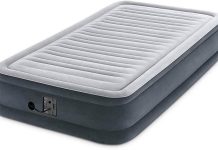Have you ever experienced the frustration of waking up in the middle of the night, only to find that your air mattress has lost half of its air? We understand the struggle all too well. From camping trips to unexpected guests, keeping an air mattress inflated throughout the night can be quite the challenge. However, fear not! In this article, we will provide you with some simple yet effective tips and tricks to ensure that your air mattress remains fully inflated, guaranteeing a comfortable and uninterrupted sleep for you or your loved ones.
Review contents
Choose a Quality Air Mattress
When it comes to selecting an air mattress, it’s essential to do your research. There are various brands and models available, each with their own features and qualities. Take the time to read reviews, compare prices, and consider your specific needs and preferences. Look for air mattresses that have a reputation for durability and comfort. This will ensure that you invest in a high-quality product that will meet your sleeping needs for years to come.
Research Different Brands and Models
Not all air mattresses are created equal. Some brands and models have a reputation for being more reliable and long-lasting than others. Before making a purchase, spend some time researching different options. Read customer reviews online and check for any common issues or complaints. Look for air mattresses that have a solid track record and positive feedback from users. By doing your due diligence, you can ensure that you choose a brand and model that will provide you with a comfortable and reliable sleeping surface.
Check for Durable Materials and Construction
One of the most important factors to consider when selecting an air mattress is the quality of its materials and construction. Look for mattresses that are made of durable and puncture-resistant materials, such as reinforced PVC or rubber. These materials will decrease the chances of leaks and damages. Additionally, check for sturdy seams and a reinforced frame that can withstand the pressure of inflation and everyday use. Investing in an air mattress with durable materials and construction will help prolong its lifespan and ensure a comfortable sleeping experience.
Properly Inflate the Air Mattress
Inflating an air mattress properly is crucial for achieving a comfortable and supportive sleep surface. There are a few key considerations to keep in mind when inflating your mattress.
Use a Pump with Pressure Gauge
Using a pump with a pressure gauge is essential to ensure that your air mattress is inflated to the right level of firmness. An overinflated mattress can cause discomfort and increase the risk of leaks or damages, while an underinflated mattress may not provide enough support. A pump with a pressure gauge allows you to monitor and adjust the air pressure to achieve the desired firmness, providing you with a comfortable and restful sleep experience.
Avoid Overinflating or Underinflating
While it may be tempting to overinflate your air mattress for extra cushioning, this can actually decrease its durability and comfort. Overinflating puts excessive pressure on the seams and materials, increasing the risk of leaks or bursts. On the other hand, underinflating can result in a sagging or uneven surface, which can lead to back pain and discomfort. It’s important to find the right balance and follow the manufacturer’s recommendations for inflation levels. This will ensure that your air mattress stays comfortable and supportive throughout the night.
Ensure a Stable Sleeping Surface
Creating a stable and level sleeping surface is essential for a comfortable night’s sleep on an air mattress. Here are a few tips to ensure stability:
Place the Air Mattress on a Level Ground
Before inflating your air mattress, ensure that the ground is level and free from any uneven surfaces. Sleeping on an uneven surface can cause discomfort and disrupt your sleep. Use a level or simply walk around the area to check for any noticeable slopes or bumps. Once you’ve found a suitable spot, lay out a clean and smooth surface, such as a tarp or a bedsheet, to provide an additional layer of protection and stability.
Remove Debris and Sharp Objects
Before placing your air mattress on the ground, carefully inspect the area for any sharp objects or debris. Rocks, sticks, or even small pieces of glass can puncture your mattress and cause leaks. Clear the area and make sure it is free from any potential hazards. Additionally, avoid placing your mattress near sharp objects or rough surfaces, such as exposed nails or rough walls. Taking these precautions will help prevent any unnecessary damages and ensure a more comfortable sleeping experience.
Maintain Optimal Air Pressure
To ensure that your air mattress stays consistently comfortable throughout the night, it’s important to monitor and maintain the air pressure.
Periodically Check Air Pressure Throughout the Night
Air mattresses can naturally lose some air pressure over time due to temperature changes, stretching of materials, or other factors. To keep your mattress at the optimal firmness, it’s a good idea to periodically check the air pressure throughout the night. If you notice that the mattress has lost some firmness, use the pump with the pressure gauge to inflate it to the desired level. By monitoring and adjusting the air pressure as needed, you can ensure a comfortable sleep surface.
Follow Manufacturer Recommendations
Each air mattress has its own recommended air pressure range for optimal performance and longevity. It’s important to follow the manufacturer’s recommendations when inflating your mattress to avoid overinflation or underinflation. The ideal air pressure may vary depending on the brand and model, so be sure to consult the instruction manual or the manufacturer’s website for specific guidelines. By following these recommendations, you can ensure that your air mattress maintains its structural integrity and provides the desired level of support.
Prevent Air Leaks
Air leaks can quickly turn a comfortable air mattress into a deflated disappointment. To avoid leaks and prolong the lifespan of your mattress, take the following precautions:
Inspect the Mattress for Any Visible Damage
Regularly inspect your air mattress for any visible signs of damage, such as punctures, tears, or worn-out areas. Look closely at the seams, valves, and overall surface of the mattress. If you notice any damage, avoid using the mattress until it has been properly repaired. Contact the manufacturer for guidance or use a patch kit specifically designed for air mattresses to address any minor repairs. By catching and addressing damages early on, you can prevent leaks and ensure the longevity of your air mattress.
Use a Patch Kit for Minor Repairs
If you discover a small puncture or tear on your air mattress, using a patch kit can be an effective way to fix the issue. Most air mattress manufacturers provide patch kits or recommend compatible ones that are designed specifically for their products. Follow the instructions included with the patch kit to properly repair the damaged area. Make sure to clean and dry the surface before applying the patch, and allow sufficient time for the adhesive to bond. By promptly patching any minor damages, you can prevent them from worsening and maintain the integrity of your air mattress.
Avoid Overloading the Mattress
Air mattresses have weight limits that should not be exceeded. Overloading the mattress can put excessive pressure on the materials and seams, increasing the risk of leaks or bursts. To avoid damaging your air mattress and ensure its longevity, it’s important to observe the weight limits set by the manufacturer.
Observe Weight Limits
Check the maximum weight capacity of your air mattress before using it. This information can usually be found in the user manual or on the manufacturer’s website. Take into account the weight of all individuals who will be sleeping on the mattress, as well as any additional factors such as pets or other items you may have on the mattress. By staying within the weight limits, you can prevent premature wear and tear and ensure the longevity of your air mattress.
Minimize Movement and Activity on the Mattress
Another way to avoid overloading your air mattress is to minimize movement and activity while on the mattress. Excessive bouncing, jumping, or rough movement can put strain on the materials and seams, making the mattress more prone to leaks or damages. Avoid any unnecessary movements or activities that may compromise the structural integrity of the mattress. Encourage a calm and gentle approach to using the air mattress, ensuring that it remains a comfortable and supportive sleep surface.
Protect the Air Mattress
To maintain the quality and performance of your air mattress, it’s important to take steps to protect it from potential damage or wear.
Use a Mattress Topper or Pad
Using a mattress topper or pad can provide an extra layer of protection for your air mattress. Not only will it offer additional cushioning and comfort, but it can also help to protect the surface from stains, spills, and general wear and tear. Look for a topper or pad that is specifically designed for air mattresses and has features such as waterproof or stain-resistant materials. By using a mattress topper or pad, you can extend the life of your air mattress and keep it in optimal condition.
Avoid Contact with Water or Moisture
Air mattresses are not designed to be waterproof. Exposing them to water or excessive moisture can cause damage and lead to mold or mildew growth. Avoid placing your air mattress in areas where it may come into contact with water, such as near open windows or close to bathrooms. If you need to use your air mattress outdoors, make sure to place it on a waterproof groundsheet or tarp. Additionally, take precautions to keep the area around the mattress dry. By protecting your air mattress from water and moisture, you can prevent potential damage and ensure its longevity.
Temperature Considerations
Extreme temperatures can affect the performance and durability of an air mattress. To keep your mattress in optimal condition, consider the following temperature considerations:
Avoid Extreme Heat or Cold
Exposing your air mattress to extreme heat or cold can potentially cause damage to the materials and affect its performance. Avoid placing your mattress near sources of heat, such as heaters or direct sunlight. Excessive heat can cause the materials to expand or soften, increasing the risk of leaks or bursts. Similarly, extremely cold temperatures can make the materials more brittle and susceptible to damages. Keep your air mattress in a location with a moderate temperature to ensure its longevity and maintain its performance.
Allow the Mattress to Acclimate to the Room Temperature
When inflating your air mattress, it’s important to allow it to acclimate to the room temperature before use. This is particularly necessary if the mattress has been stored in a cold or hot environment. Extreme temperature changes can affect the air pressure inside the mattress and potentially lead to discomfort or damages. Before using the mattress, inflate it and let it sit for at least 10-15 minutes, allowing it to adjust to the room temperature. This will help ensure that the mattress maintains its stability and provides a comfortable sleep surface.
Proper Storage
Properly storing your air mattress when not in use is crucial for maintaining its condition and preventing unnecessary damages.
Deflate and Pack the Air Mattress Correctly
When it’s time to store your air mattress, make sure to deflate it fully before packing it away. Remove any remaining air by opening all the valves and gently pressing or rolling from one end to the other. Once deflated, fold or roll the mattress tightly, making sure to remove any excess air. Some air mattresses come with a storage bag or carry case, which is ideal for protecting the mattress during storage. If not, consider using a large, sturdy plastic bag or airtight container to keep it clean and protected.
Store in a Dry and Cool Location
Moisture and humidity can cause damage to your air mattress during storage. It’s important to store the mattress in a dry and cool location to prevent the growth of mold or mildew. Choose an area that is free from moisture, such as a closet or a dry basement. Make sure the storage space is well-ventilated to allow air circulation and prevent the buildup of moisture. By storing your air mattress properly, you can ensure that it remains in optimal condition and ready to use whenever needed.
Carry out Regular Maintenance
Regular maintenance is key to preserving the quality and longevity of your air mattress. By following a few simple steps, you can keep your air mattress clean and well-maintained.
Cleaning and Removing Stains
To clean your air mattress, start by gently wiping the surface with a damp cloth or sponge. Use mild soap or a mixture of water and vinegar for any stubborn stains or dirt. Avoid using harsh chemicals or abrasive cleaners, as they can damage the materials. Once cleaned, allow the mattress to air dry completely before folding or storing it. Regular cleaning will not only keep your air mattress fresh and hygienic but also prevent the buildup of dirt or stains that can affect its performance.
Inspection for Wear and Tear
Regularly inspect your air mattress for any signs of wear and tear. Check the seams, valves, and overall surface for any rips, tears, or damages. If you notice any issues, address them promptly to prevent further deterioration. Additionally, pay attention to the firmness and comfort level of your mattress during use. If you notice any significant changes or sagging, it may be an indication that the mattress needs repair or replacement. By performing regular inspections, you can identify and address any potential issues early on, ensuring the longevity of your air mattress.
In conclusion, keeping an air mattress inflated all night and maintaining its quality and comfort is achievable with a few simple steps. By choosing a quality air mattress, properly inflating it, ensuring a stable sleeping surface, maintaining optimal air pressure, preventing air leaks, avoiding overloading, protecting the mattress, considering temperature factors, storing it correctly, and carrying out regular maintenance, you can enjoy a comfortable and supportive sleeping experience for years to come. By following these tips and taking care of your air mattress, it will continue to provide you with a cozy and reliable sleep surface for many nights of restful sleep.































